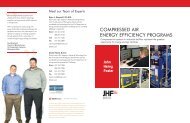The Turbo Air® 3000 Centrifugal Compressor Compressor Handbook
The Turbo Air® 3000 Centrifugal Compressor Compressor Handbook
The Turbo Air® 3000 Centrifugal Compressor Compressor Handbook
You also want an ePaper? Increase the reach of your titles
YUMPU automatically turns print PDFs into web optimized ePapers that Google loves.
<strong>The</strong> <strong>Turbo</strong> Air <strong>3000</strong> <strong>Centrifugal</strong> <strong>Compressor</strong> Operator’s Manual<br />
Condensate Drain Piping<br />
During air compressor operation, condensate collects in each intercooler chamber as the air is cooled.<br />
(This is not the case when the compressor is used in dry nitrogen service.) In order to prevent the<br />
condensate from being carried over and entering the next stage of compression, the condensate in<br />
each of the intercooler chambers must be drained into an open drain or trough. <strong>The</strong> open drain<br />
allows not only visual verification of condensate removal, but it also assures that the condensate will<br />
not be drawn back into the compressor when the compressor is unloaded.<br />
A—22<br />
CAUTION:<br />
Do not manifold the condensate drains. Since the cooler cavities operate at different<br />
pressures, manifolding will cause malfunctions due to excessive amounts of condensate<br />
from higher pressure chambers being forced into lower pressure chambers and consequently<br />
through the compressor.<br />
A variety of control devices can be used in the condensate removal piping system, including:<br />
· Standard gate valves, operated by hand.<br />
· Float traps which are self-actuating.<br />
· Solenoid valves, operated by the Vantage Control System.<br />
Three ½” NPT connections (one for each cooler cavity) are located at the front of the compressor. <strong>The</strong><br />
condensate piping and control devices attach to these connections. Figure A—12 illustrate a typical<br />
condensate drain piping arrangement. It is also necessary to include a manual bypass valve and piping<br />
with whichever type of drain control device is utilized. <strong>The</strong> isolation valves ahead of the control device<br />
are optional.<br />
It is also advisable to keep the condensate draining system open during shutdown to prevent condensate<br />
accumulation in the compressor. This will also provide compressor protection in case of an intercooler<br />
tube failure.<br />
A<br />
B<br />
Figure A—12. Typical Condensate Removal Piping Arrangement<br />
A. Hand Valve<br />
B. Trap or Solenoid Valve



